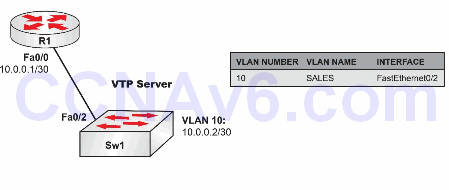Lab Objective:
The objective of this lab exercise is to verify the different Spanning Tree port states (i.e., Listening, Learning, etc.) and understand the IOS commands that can be used to determine the state of a port at any given time.
Lab Purpose:
Understanding the different Spanning Tree Protocol port states is a fundamental skill. In Spanning Tree operation, ports transition from a Blocking state -> Listening state -> Learning state -> Forwarding state. A switched network is said to be converged when all ports are in the Forwarding or Blocking state. As a Cisco engineer, as well as in the Cisco CCNA exam, you will be expected to know the different Spanning Tree port states.
Certification Level:
This lab is suitable for CCNA certification exam preparation.
Lab Difficulty:
This lab has a difficulty rating of 5/10.
Readiness Assessment:
When you are ready for your certification exam, you should complete this lab in no more than 15 minutes.
Lab Topology:
Please use the following topology to complete this lab exercise:

Task 1:
In preparation for VLAN configuration, configure a hostname on Sw1 and R1 as illustrated in the topology.
Task 2:
Configure and verify Sw1 as a VTP server in the VTP domain named CISCO. The VTP domain should have the password CISCO.
Task 3:
Configure VLAN10 on Sw1 as illustrated in the topology. Configure FastEthernet0/2 on Sw1 as an access port in VLAN10 and bring up the FastEthernet0/0 interface on router R1.
Configure the IP address on R1’s FastEthernet0/0 and configure VLAN10 with the IP address on Sw1 as illustrated in the topology. Verify IP connectivity using pings.
Task 4:
On Sw1, issue a shutdown and then a no shutdown command on FastEthernet0/2. Verify the transition of the Spanning Tree state of the port to Forwarding. Make sure that you see the interface in at least three different Spanning Tree states.
Configuration and Verification
Task 1:
For reference information on configuring hostnames, please refer to earlier labs.
Task 2:
For reference information on configuring a VTP domain and password, please refer to earlier labs.
Task 3:
For reference information on configuring standard VLANs, please refer to earlier labs. To check the IP address for VLAN10 on the switch, issue the following:
Sw1#show ip interface brief
NOTE: VLAN1 is the default management interface on Cisco switches. When configuring another interface with an IP address, it is good practice to shut down interface VLAN1 and issue a no shutdown command on the new management interface you are configuring.
Task 4:
Sw1#conf t Enter configuration commands, one per line. End with CTRL/Z. Sw1(config)#int fastethernet0/2 Sw1(config-if)#shut Sw1(config-if)#no shutdown Sw1(config-if)#end Sw1# Sw1#show spanning-tree interface fastethernet0/2 no spanning tree info available for FastEthernet0/2
After about 10 to 15 seconds, the port transitions to the Listening state as shown below:
Sw1#show spanning-tree interface fastethernet0/2 Vlan Role Sts Cost Prio.Nbr Type ---------------- ---- --- --------- -------- -------- VLAN0010 Desg LIS 100 128.2 Shr
After about 10 to 15 seconds, the port transitions to the Learning state as shown below:
Sw1#show spanning-tree interface fastEthernet0/2 Vlan Role Sts Cost Prio.Nbr Type ---------------- ---- --- --------- -------- ------- VLAN0010 Desg LRN 100 128.2 Shr
After about 10 to 15 seconds, the port transitions to the Forwarding state as shown below:
Sw1#show spanning-tree interface fastethernet0/2 Vlan Role Sts Cost Prio.Nbr Type ---------------- ---- --- --------- -------- -------- VLAN0010 Desg FWD 100 128.2 Shr
Possible interface types (according to Cisco) include:
- P2p/Shr—The interface is considered a point-to-point (shared) interface by Spanning Tree.
- Edge—The port is configured as an STP edge port (either globally using the default command or directly on the interface) and no BPDU has been received.
- Network—The port is configured as an STP network port (either globally using the default command or directly on the interface).
- *ROOT_Inc, *LOOP_Inc, *PVID_Inc, *BA_Inc, and *TYPE_Inc—The port is in a broken state (BKN*) for an inconsistency. The broken states are Root Inconsistent, Loopguard Inconsistent, PVID Inconsistent, Bridge Assurance Inconsistent, or Type Inconsistent.
